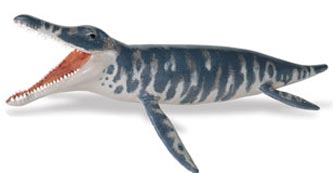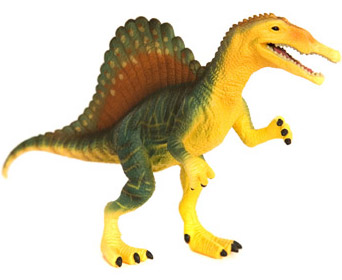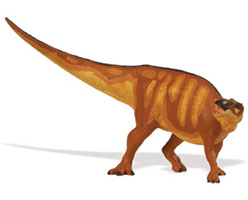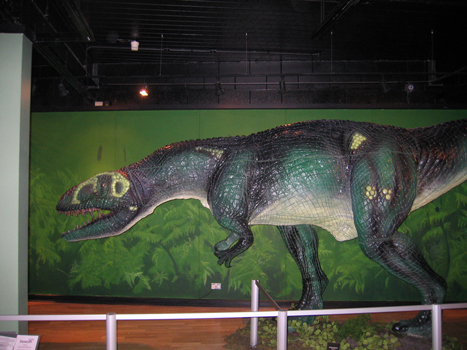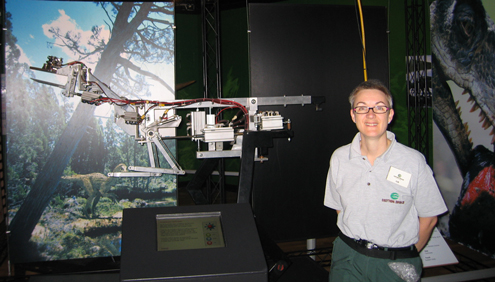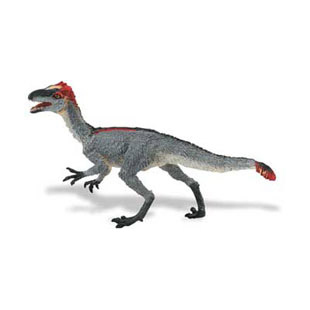American Scientists Provide Evidence of “Warm-Blooded” Dinosaurs
Analysis of Teeth Provides Indication of “Warm-Blooded” Dinosaurs
Researchers at the California Institute of Technology have been utilising an isotope analysis technique that they have developed to examine the body temperatures of extinct vertebrates and they have come up with some interesting data relating to sauropods (long-necked dinosaurs). New research into “warm-blooded” dinosaurs.
The debate on whether the Dinosauria were endothermic (warm-blooded) or ectothermic (cold-blooded) has raged since the middle of the 19th century, but many scientists have now concluded that a number of dinosaur families were active animals and not the ponderous animals envisaged by academics in the last Century and earlier. The science of palaeontology has certainly come along way since the time of Owen, Mantell, Seeley et al, alvarezsaurids, ornithomimids, oviraptorosaurids are now all thought to be warm-blooded dinosaurs. However, to find evidence of endothermy in sauropods, those huge lumbering lizard-hipped dinosaurs is quite remarkable.
“Warm-blooded” Dinosaurs
In a new paper, published by researchers at the California Institute of Technology (Caltech), scientists claim that isotope analysis using fossilised teeth from sauropods provides evidence that these long-necked giants had internal body temperatures as high as modern birds and on a par with our own species and most other mammals. This new approach to taking a dinosaur’s temperature provides evidence that even the largest dinosaurs may have been endothermic.
Sauropods were plant-eating dinosaurs with small heads, long necks and tails and massive bodies supported by trunk-like legs. They evolved in the Late Triassic and survived until the very end of the Cretaceous. Well know sauropods include Apatosaurus (formerly known as Brontosaurus), Diplodocus and Brachiosaurus.
An Illustration of Apatosaurus (Sauropod)
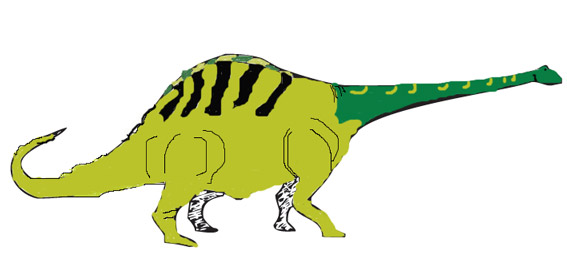
Picture credit: Everything Dinosaur
Robert Eagle, a postdoctoral scholar at Caltech and lead author on the scientific paper commented:
“This is like being able to stick a thermometer in an animal that has been extinct for 150 million years.”
Co-author John Eiler, the Robert P. Sharp Professor of Geology and Professor of Geochemistry stated:
“The consensus was that no one would ever measure dinosaur body temperatures, that it’s impossible to do.”
Yet, using a technique pioneered in Eiler’s laboratory, the team did just that.
The researchers analysed eleven teeth, dug up in Tanzania, Wyoming, and Oklahoma, that belonged to Brachiosaurus (possibly a Giraffatitan) and Camarasaurus. These animals lived during the Late Jurassic. The team found that the Brachiosaurus had a temperature of about 38.2 degrees Celsius (100.8 degrees Fahrenheit) and the Camarasaurus had one of about 35.7 degrees Celsius (96.3 degrees Fahrenheit), warmer than modern and extinct crocodiles and alligators but cooler than birds. The measurements are accurate to within one or two degrees, Celsius, the researchers claim. The normal human body temperature is around 98.4 degrees Fahrenheit, putting these dinosaurs definitely in the endothermic group.
Eagle said:
“Nobody has used this approach to look at dinosaur body temperatures before, so our study provides a completely different angle on the long-standing debate about dinosaur physiology.”
The fact that the temperatures were similar to those of most modern mammals might seem to imply that dinosaurs had a warm-blooded metabolism. But, the researchers say, the issue is more complex. Because large sauropod dinosaurs were so huge, they could retain their body heat much more efficiently than smaller mammals like us humans.
John Eiler explained the physics of volume versus surface area in terms of its impact on thermal regulation stating:
“If you’re an animal that you can approximate as a sphere of meat the size of a room, you can’t be cold unless you’re dead. So even if dinosaurs were “cold blooded” in the sense that they depended on their environments for heat, they would still have warm body temperatures.”
Another author of this study, Assistant Professor at the UCLA and visiting researcher in Geochemistry at Caltech, Aradhna Tripati stated:
“The body temperatures we’ve estimated now provide a key piece of data that any model of dinosaur physiology has to be able to explain. As a result, the data can help scientists test physiological models to explain how these organisms lived.”
The measured temperatures are lower than what’s predicted by some models of body temperatures, suggesting there is something missing in scientists’ understanding of dinosaur physiology. These models imply dinosaurs were so-called gigantotherms, that they maintained warm temperatures by their sheer size. To explain the lower temperatures, the researchers suggest that the dinosaurs could have had some physiological or behavioural adaptations that allowed them to avoid getting too hot. The dinosaurs could have had lower metabolic rates to reduce the amount of internal heat, particularly as large adults. They could also have had something like an air-sac system to dissipate heat.
There is certainly evidence for this in lizard-hipped dinosaur fossilised bones. Alternatively, they could have dispelled heat through their long necks and tails. These parts of their body could have acted as radiators, as indeed could the long spines, frills and spikes associated with some sauropod genera. For example, could the extended neural spines on the fossilised vertebrae of Amargasaurus point to being supports for a thermal regulation structure.
Casting Amargasaurus and other Sauropods in a New Light
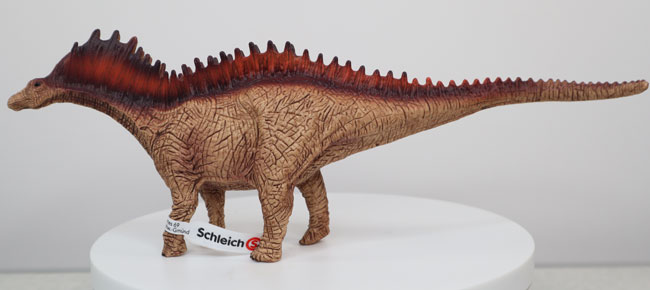
The Schleich Amargasaurus dinosaur model shown in lateral view. Picture credit: Everything Dinosaur.
Picture credit: Everything Dinosaur
To view replicas and models from the Schleich range: Schleich Prehistoric Animal Models and Figures.
The illustration above shows an Amargasaurus, a diplodocid could the large, spines jutting up from the backbone support a thermal regulation device such as a sail-like structure?
Previously, researchers have only been able to use indirect ways to gauge dinosaur metabolism or body temperatures. For example, they infer dinosaur behaviour and physiology by figuring out how fast they ran based on the spacing of dinosaur tracks, studying the ratio of predators to prey in the fossil record, or measuring the growth rates of bone. But these various lines of evidence were often in conflict.
Eiler said:
“For any position you take, you can easily find counter examples. How an organism budgets the energy supply that it gets from food and creates and stores the energy in its muscles—there are no fossil remains for that. So you just sort of have to make your best guess based on indirect arguments.”
But Eagle, Eiler, and their colleagues have developed a so-called clumped-isotope technique that shows that it is possible to take body temperatures of dinosaurs—and there’s no guessing involved.
Eiler went onto state:
“We’re getting at body temperature through a line of reasoning that I think is relatively bullet proof, provided you can find well-preserved samples.”
In this method, the researchers measure the concentrations of the rare isotopes carbon-13 and oxygen-18 in bioapatite, a mineral found in teeth and bone. How often these isotopes bond with each other, or “clump”, depends on temperature. The lower the temperature, the more carbon-13 and oxygen-18 tend to bond in bioapatite. So measuring the clumping of these isotopes is a direct way to determine the temperature of the environment in which the mineral formed, in this case, inside the dinosaur.
Eiler explains:
“What we’re doing is special in that it’s thermodynamically based. Thermodynamics, like the laws of gravity, is independent of setting, time, and context.”
Because thermodynamics worked the same way 150 million years ago as it does today, measuring isotope clumping is a robust technique. Identifying the most well-preserved samples of dinosaur teeth was one of the major challenges of the analysis, the researchers say, and they used several ways to find the best samples. For example, they compared the isotopic compositions of resistant parts of teeth, the enamel, with easily altered materials, dentin and fossil bones of related animals. Well-preserved enamel would preserve both physiologically possible temperatures and be isotopically distinct from dentin and bone.
The next step would be to take temperatures of more dinosaur samples and extend the study to other species of extinct vertebrates, the researchers say. In particular, taking the temperature of unusually small and young dinosaurs would help test whether dinosaurs were indeed gigantotherms. Knowing the body temperatures of more dinosaurs and other extinct animals would also allow scientists to learn more about how the physiology of modern mammals and birds evolved.
This research was supported by the National Science Foundation and the German Research Foundation and this article has been prepared using a California Institute of Technology press release.


